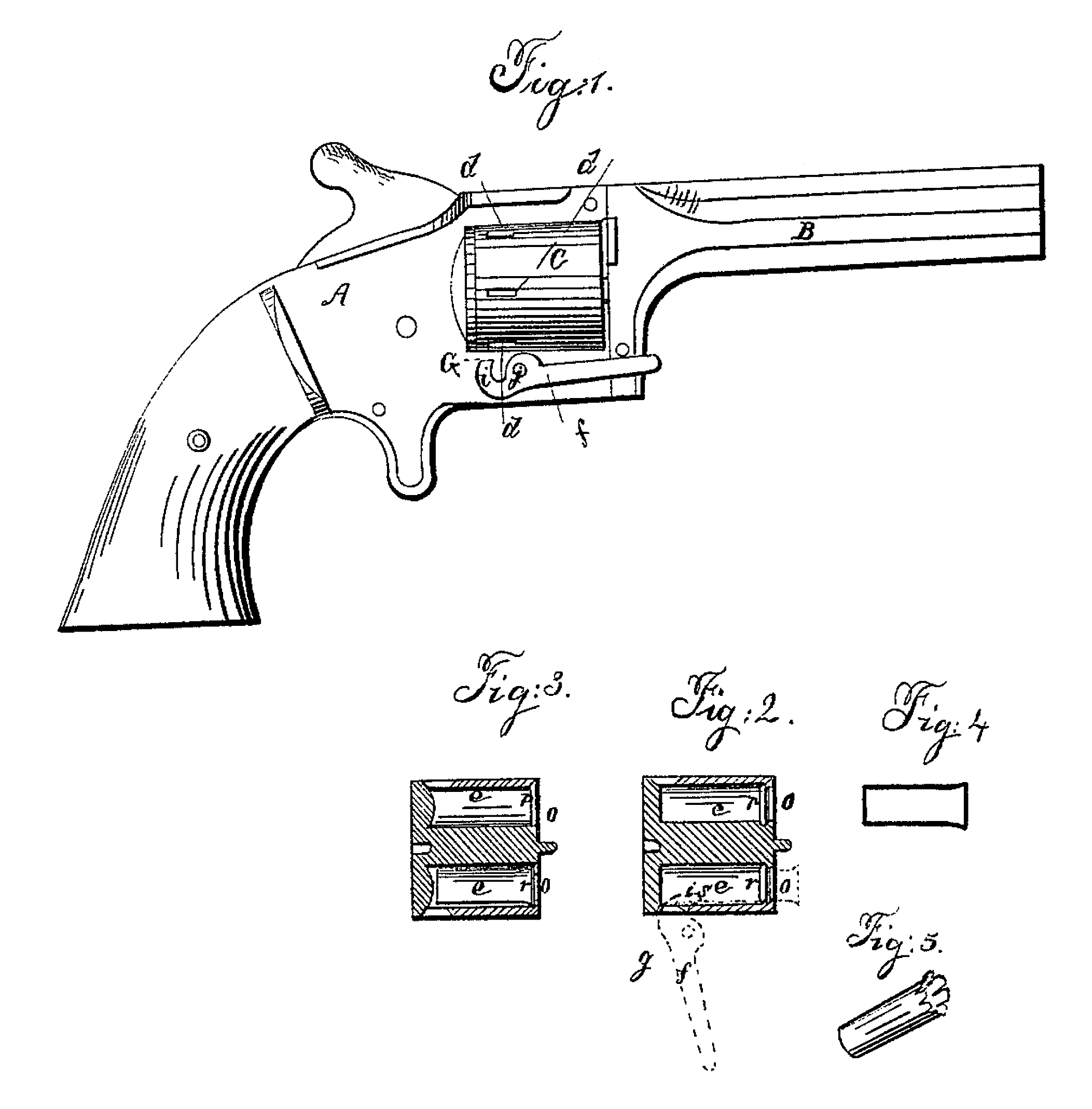US 52105
UNITED STATES PATENT OFFICE.
S. W. WOOD, OF CORNWALL, NEW YORK.
IMPROVEMENT IN CARTRIDGE-RETRACTORS FOR REVOLVING FIRE-ARMS.
Specification forming part of Letters Patent No. 52,105, dated January 16, 1866.
To all whom it may concern:
Be it known that I, S. W. WOOD, of Cornwall, in the county of Orange and State of New York, have invented certain new and useful Improvements in Revolving Fire-Arms; and I do hereby declare the following to be a full, clear, and exact description thereof, reference being had to the annexed drawings, making part of this specification.
The nature of my invention consists in a lever for removing metallic cases or metallic cartridges from the chambers in revolving fire-arms, pivoted to the frame or handle in front of the bottom of the chambers.
Figure 1 is a side elevation of a revolving pistol having my cartridge-ejector applied; Fig. 2, a vertical longitudinal section of a revolving cylinder, showing grooves in the front ends of the chambers. Fig. 3 is a similar section, showing a modified form of the groove or chamber. Fig. 4 is a vertical longitudinal section of a metallic cartridge-case adapted to the chambers; Fig. 5, a perspective view of a metallic cartridge-case having flutes or corrugations formed in the front end, which is also adapted to a chamber having grooves in the front.
To enable others skilled in the art to make and use my improvement in revolving fire-arms, I will proceed to describe the same in detail.
Like letters indicate similar parts in all the figures.
The frame A, barrel B, and lock represented in the accompanying drawings are similar to many pistols now in use, and require no further description here, as they form no part of my invention.
The cylinder C is perforated with openings d in the periphery, leading respectively into the chambers e, through which openings the lever f operates to eject the empty metallic case or cartridge. The pivot g of the lever f is located in the frame A, nearly opposite the front ends of the openings d, so that the short end i of the lever f may enter the openings d at the rear ends, and, moving in the arc of a circle, force the cartridges or empty cases for ward in the chambers sufficiently far to be removed by the fingers, provided they do not leave the chambers of their own gravity, when the barrel is turned downward. The lines in red, Fig. 2, represent the lever in position, having entered one of the openings d and forced a metallic case sufficiently forward to relieve it from the chamber, the shell or case and chamber being tapering from their base. The end of the lever f that enters the chambers is hooked in the radius of a circle, or nearly so, the pivot g being the fulcrum, and placed about opposite the front ends of the openings d, so that when turned on its axis it enters the chambers e through the openings d and moves forward within the chambers a distance equal to the length of the hook. The end s of the hooked part of the lever is flat, and bears directly against the rear end of the cartridge-case, forcing it forward in the chamber while being moved on its axis. The lever may be more or less hooked to suit the constructor, and might be made straight, or nearly so. The groover on the inner periphery of the front end of the chamber c is in depth about equal to the thickness of the metallic case, so that when the case is inserted into the chamber the front end of which, being slightly flared or bell-shaped, by slight pressure will pass the extreme front edge and enter the groove r, as represented in red, Fig. 3, the elasticity of the metal being sufficient to pass the front edge, o, and expand into the groove r when inserted in proper position to be discharged, thus being retained within the chamber until forced forward beyond the groove by the lever f. The form of the groove is not material, so long as it retains the cartridge within the chamber and permits the case to be forced forward in the chamber over the groove, by means of the lever or otherwise.
Having thus fully described my invention, what I claim therein as new, and desire to secure by Letters Patent, is–
A lever for removing metallic cartridges or empty cases from the chambers of the cylinder in revolving fire-arms, pivoted farther forward than the bottoms of the chambers, or in such a manner as to act directly by lever power upon the cartridges or cartridge-cases, substantially as herein set forth.
S. W. WOOD.
Witnesses:
ROBERT T. B. EASTON,
JONATHAN MARSHALL.

